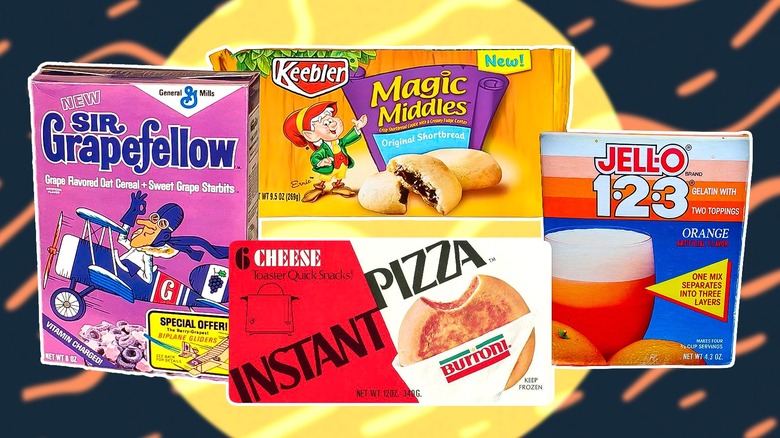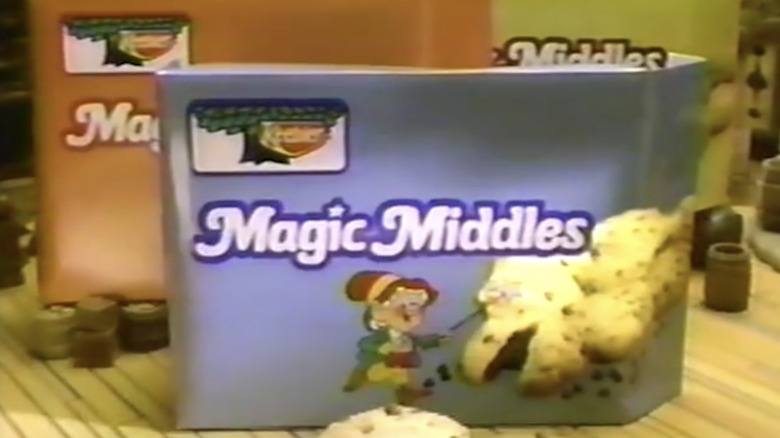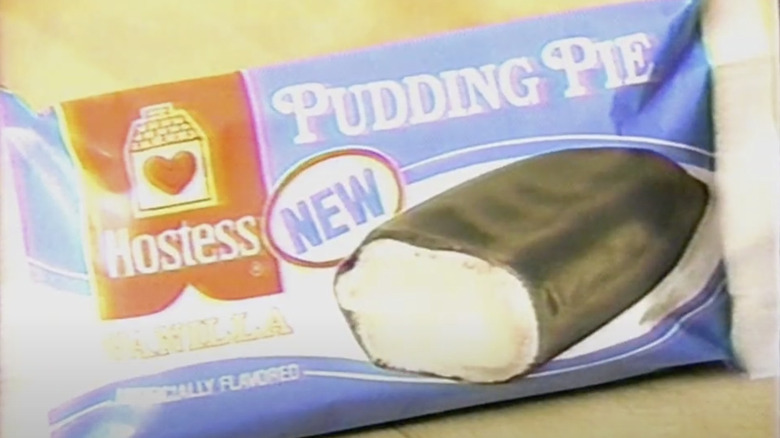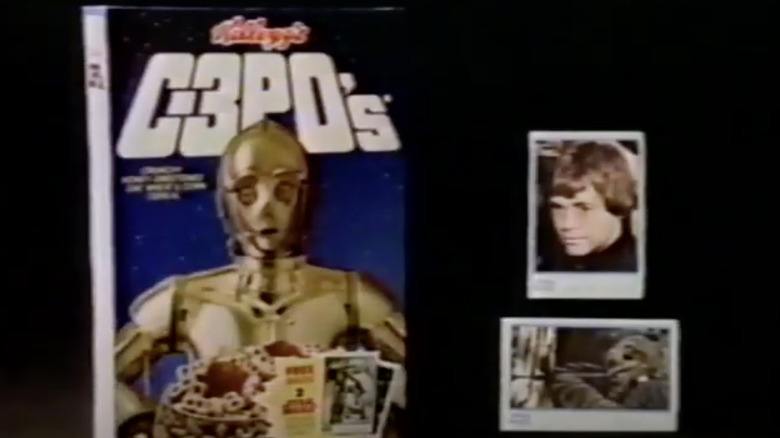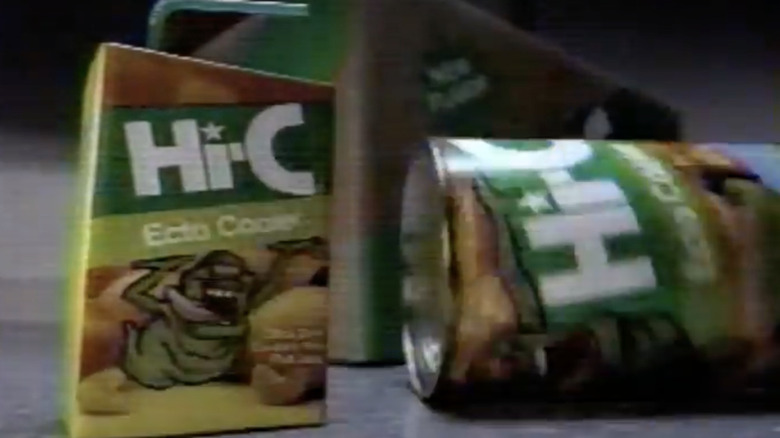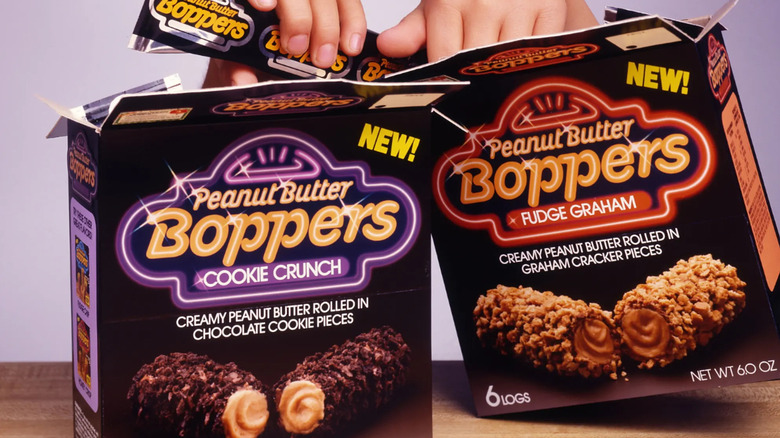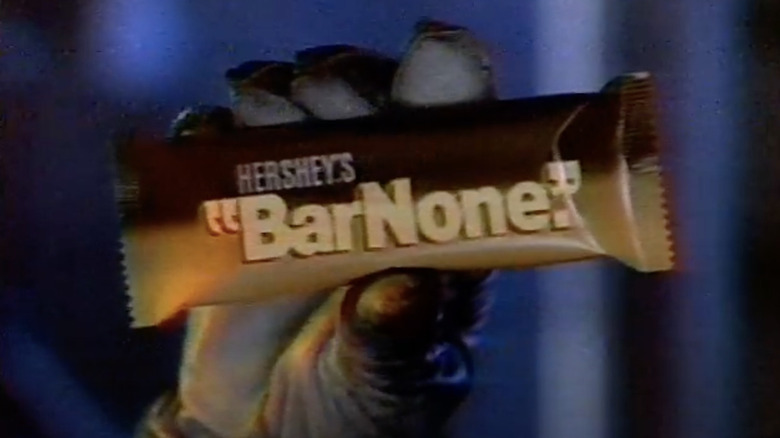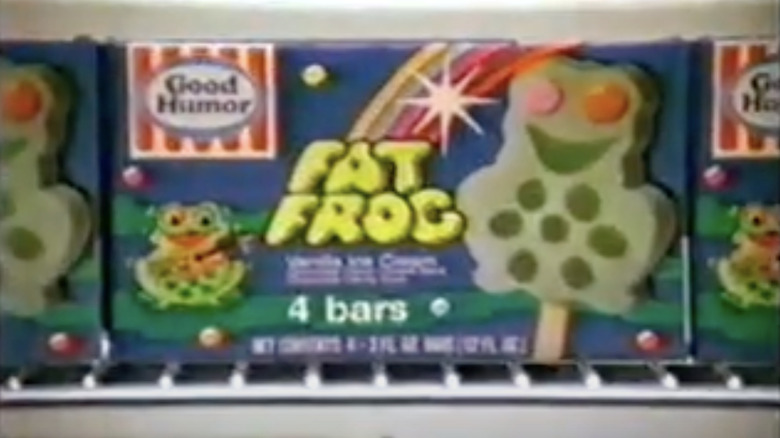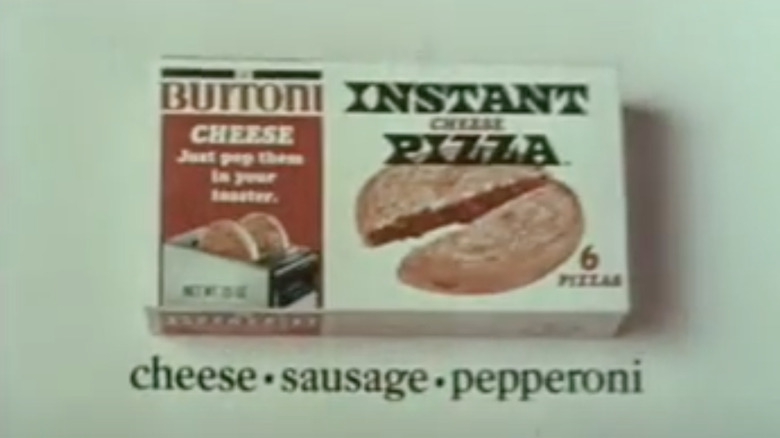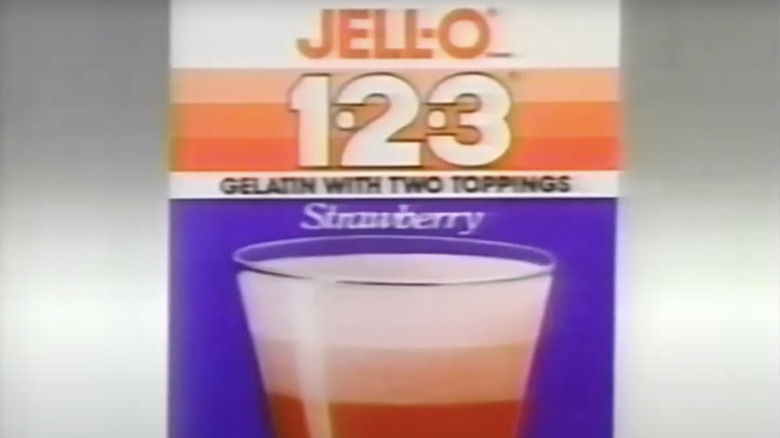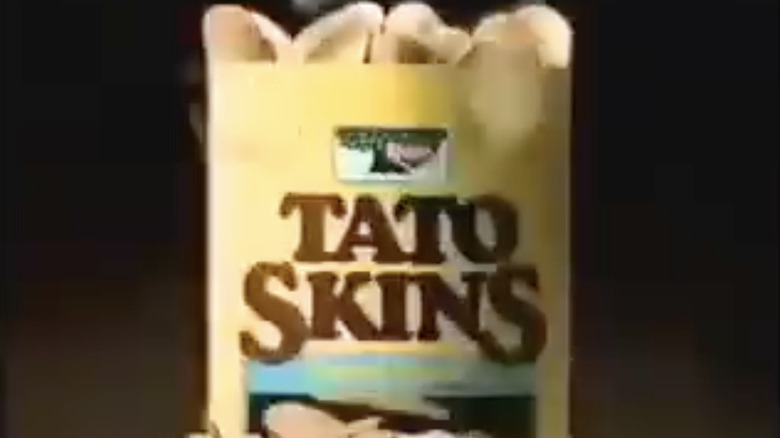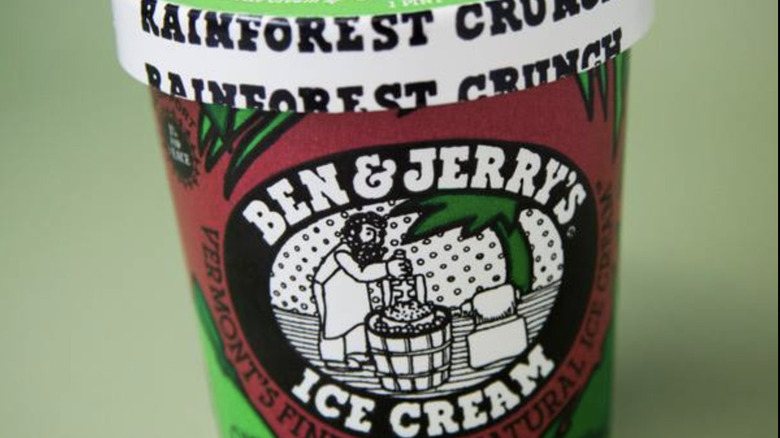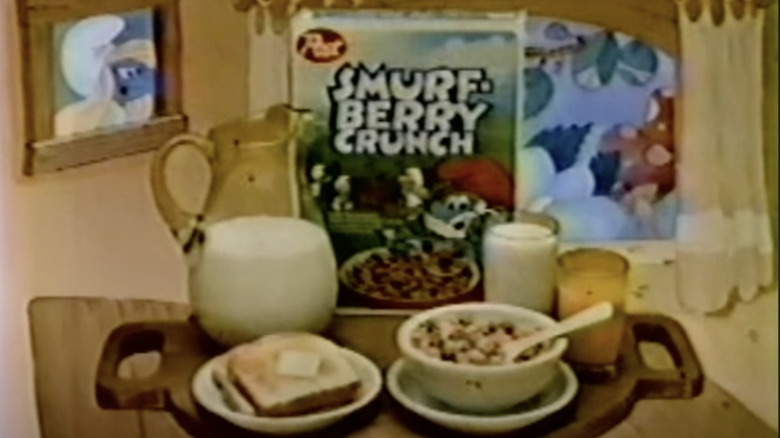12 Snacks From The '80s No One Remembers Anymore
Snacking wasn't always as popular as it is today. In fact, prior to the 20th century, snacking was actually looked down on as it created associations with the working class. As technology and society shifted, new inventions made snacking a more broadly acceptable behavior. The microwave was one invention that offered homemakers speed and efficiency in cooking processes that used to take much longer. Some snack foods, like microwave popcorn, were literally created because of the microwave frequency that powers the appliance. On top of that, snacking likely also grew due to the growth of the supermarket in the United States, which offered consumers more choices than ever before.
By the time the '80s rolled around, snacking was already a part of everyday life (and has continued to grow in popularity in the decades since), and food companies saw an opportunity. Some foods that we still eat today, like Cool Ranch Doritos and Lunchables, were first launched during the decade. But there are some snacks from the '80s that didn't stand the test of time, and we're exploring 11 of them that were either discontinued or largely forgotten about.
Keebler Magic Middles
Keebler products have been stocked in at-home pantry shelves since the 19th century, when Godfrey Keebler created the first Keebler cookie. By 1944, there were 16 Keebler bakeries across the country, and the brand has continued to grow ever since. Today, some of the brand's most famous cookies are the Fudge Stripes and Sandies, often hawked to consumers via commercials featuring those adorable little elves. But there was a Keebler cookie back in the '80s that people loved dearly called Magic Middles, which were introduced in 1989 before being discontinued in 2011.
The cookie base was shortbread, which is known for its crumbly texture and buttery, rich taste. Inside the shortbread was a "magic middle" of either fudge or peanut butter. A year after the release of Magic Middles, a mini version was produced with bite-sized cookies called Mini Middles. While there hasn't been any news regarding a resurgence, a petition has been made calling on the Kellogg Company to bring the cookies back into production.
Hostess Pudding Pie
Check out the snack aisle today, and the Hostess logo may very well stare back at you. Ding Dongs, Zingers, and HoHos are just some of Hostess Cakes' offerings, all born from the bakery that Robert Ward founded in Manhattan back in 1849. As the bakery that Ward founded grew into a larger food empire, the company would go on to acquire Wonder Bread, which still remains an iconic American brand today, and began to produce Twinkies (try grilling them at home for a delicious, nostalgic snack). Both of those brands are still sold today, though there was a time when Twinkies were discontinued, while other nostalgic Hostess treats weren't so lucky.
A Hostess Pudding Pie could be counted on for a sugar rush since the interior was filled with gooey pudding, and the exterior had a chocolate shell coating. A 1986 commercial touted the release of the chocolate flavor Pudding Pie with thick, creamy chocolate pudding at the center alongside the original vanilla flavor. While the Pudding Pies of the '80s were discontinued, a 1991 branding exercise with the Teenage Mutant Ninja Turtles brand brought back vanilla Pudding Pies, this time with a green exterior to match turtle shells.
C-3PO Cereal
Calling all "Star Wars" fans! Did you know that back in the '80s, everyone's favorite golden droid had his own cereal? A year after the third Star Wars film "Return of the Jedi" came out, Kellogg's launched a "double-o" shaped cereal as an homage to C-3PO. Sticker trading cards of major "Star Wars" characters — Han, Leia, and Luke, to name a few — were in every box, and commercials even featured C-3PO gallivanting about the galaxy with his friend R2-D2.
C-3PO cereal, like many cereals, had an oat, wheat, and corn base, with a slight sweetness reminiscent of the Honeycomb cereal that we still eat today. But we imagine the taste wasn't what kept fans coming back, but rather the experience. In addition to trading cards, the boxes themselves also had cut-out masks on the back featuring characters' faces. Mark Hamill — Luke Skywalker himself — even mentioned the masks in an interview once.
Hi-C Ecto Cooler
"Ghostbusters" took the world by storm when it was released in 1984 and is still today the highest-grossing film of the series, despite four sequels (as well as the second-highest-grossing film of 1984). Fans were exposed to the supernatural in a totally new way as they followed the adventures of four scientists in New York City in their battle against ghoulish creatures from another dimension.
In the late '80s, Hi-C launched a partnered drink called the Ecto Cooler that featured Slimer, a gelatinous green original character from "Ghostbusters", on the packaging. The Ecto Cooler took Hi-C's already present Citrus Cooler beverage, which was a citrus (tangerine and orange) juice-flavored drink, and made it green. The drink has come and gone throughout the years as new "Ghostbusters" films get released, even being produced as recently as 2021, though that drop was for commemorative purposes and wasn't widely available.
Peanut Butter Boppers
General Mills is one of the largest snack companies around the world today. Since 1928, it has been creating snack foods that have fed generations. From Pillsbury to Yoplait to Nature Valley, General Mills is behind many snacks that still fuel our days. But, as with any company, even well-loved items have to be put on the back burner to make room for new products, and the Peanut Butter Boppers are one such snack.
Peanut Butter Boppers were launched in 1985 by Nature Valley with three flavors: Fudge Chip, Honey Crisp, and Peanut Crunch. The snack itself was essentially a solid log of peanut butter rolled in a crunchy coating, then packaged. Just a year after launch, Nature Valley introduced two new flavors to the lineup. In 1986, General Mills even shared that after a mere 90 days on sale to the public, Peanut Butter Boppers had captured 9% of the wholesome snack market. Despite its once larger-than-life popularity, the snack is no longer available, but copycats can still be made at home thanks to a recipe shared by Nature Valley.
Hershey's BarNone
There have been countless popular chocolate bars gracing store shelves over the years, especially from Hershey's, but despite many of the classics still being available for purchase, other flavors weren't so fortunate. In 1987, Hershey's released the BarNone candy bar, which featured layers of chocolate wafers, chocolate cream, and peanuts with the entire bar covered in a layer of chocolate. The candy bar was meant to appeal to those with more discerning candy tastes, further emphasized by the "for people with a passion for chocolate" slogan featured on advertisements.
But Hershey's might have made a mistake in trying to evolve the candy bar. In 1992, the powers that be split the candy bar into two sticks — similar to Kit Kats. Whether that was the proverbial nail in the coffin or other competition snuffed out sales, the BarNone candy bar was eventually discontinued in 1997.
Fat Frog
Good Humor has been an integral part of summers spent eating ice cream in the sun since 1920. Harry Burt, Good Humor's founder, was looking to make a chocolate coating for ice cream but was told (by his daughter, no less) that it was too messy. Then, Burt's son came up with the idea of freezing ice cream around wooden sticks for easy handling, and Good Humor ice cream on a stick took off.
By the time the '80s rolled around, Good Humor was producing themed ice cream bars, including the Fat Frog. The Fat Frog was, as you may have guessed, shaped like a large frog. The ice pop was fruit-flavored, green, and featured two large bulbous red gumball eyes. While the Fat Frog is no longer available in stores, Good Humor welcomes fans to share their feedback and love of past ice creams on the off chance they get resurrected from the ice cream graveyard.
Buitoni Instant Pizza
We are all about convenience, and snack foods have always been about great taste with minimal effort. It's one of the reasons foods like Pizza Pockets and Pop-Tarts are still so popular decades after they were first launched. And food lovers continue to innovate at home with things like tortilla burgers and toaster quesadillas, but they weren't the first to do it.
In the '70s and '80s, Buitoni sold Instant Toaster Pizzas, which are exactly what they sound like. Packages were sold with frozen pizzas (cheese, sausage, or pepperoni-flavored) fully encased in dough and placed in the toaster. After a certain amount of time, the little discs would pop up and be ready to eat.
Today, Buitoni is out of the pizza game, focusing instead on selling pastas, sauces, and assorted shredded cheeses. That hasn't stopped voracious fans from calling on the company to bring back the product, though it doesn't seem that likely that we'll see these exact pizzas anytime soon.
Jell-O 1-2-3
In 1969, Jell-O debuted a product that created three layers of Jell-O in a new spin on the food that had been around since 1897. Jell-O 1-2-3 came in one package, but resulted in three distinctly different layers in each dessert. One layer was the standard fruit gelatin, which is what an average box of Jell-O is. The second turned into a creamy layer, and the final layer had a fluffier texture. The magic behind the dessert was that once mixed in a blender, the layers were meant to separate themselves during the chilling process without any additional work.
There are still ways to make this, even though it's been discontinued since the mid-'90s. Though the process isn't as simple as dumping out a container into a blender, a dupe of Jell-O 1-2-3 can be made with a packet of Jell-O and whipped topping. Due to the density of fats in the mixture, separation will occur to get the telltale layers.
Keebler Tato Skins
Before TGI Fridays dominated the potato skin game, Keebler had Tato Skins. We may know Keebler today for sweet snacks, but in 1985, the elves came out with a potato chip that was made from the skin and flesh of potatoes. Most potato chips today (and recipes on how to make them at home) don't use the skin, but it's said to create a sturdier chip texture and more of a bite. The advertisements for Tato Skins harp on the differentiation of using "potatoes and skins," and fans still remember the distinct crunch difference between Tato Skins and other brands.
There were a handful of flavors to choose from, such as Cheese n' Bacon and Sour Cream n' Chives, Baked Potato, and Barbecue. While they aren't sold anymore (they were discontinued in 2000), some people say that the TGI Friday's Potato Skins chips taste similar, though not quite the same.
Ben & Jerry's Rainforest Crunch
Ben & Jerry are the pairing just about every ice cream lover has heard of, thanks to the ice cream brand that has dreamed up flavors like Cherry Garcia, Phish Food, and Half Baked. Not only is the ice cream delicious and revered, but the brand's ethos has been a driving force since the company's inception in 1978. In fact, even after the company was bought by Unilever, Ben & Jerry's has continued to focus on supporting social and environmental justice around the world.
In 1989, Ben & Jerry's introduced Rainforest Crunch, and though it only lasted 10 years, the flavor made some waves. The ice cream flavor was created with protecting the Amazonian rainforest in mind and the goal to use the proceeds from the flavor to help support the people of the Brazilian Amazon. Unfortunately, that didn't come to pass as the nuts used in Rainforest Crunch were mostly from larger agribusinesses, not local nut-shelling cooperatives as had been advertised. Since then, it's joined the ranks of other discontinued Ben & Jerry's flavors.
Smurf-Berry Crunch Cereal
The small, blue Smurfs (not elves or leprechauns but distinctly their own species) were created by Pierre Culliford, also known as Peyo. Peyo was an artist and comics writer, and before he ever wrote the Smurfs into existence, he created the "Johan And Peewit" comic, which followed the adventures of two boys in Medieval Europe. The Smurf characters were set up as supporting characters in that comic and eventually evolved into their own comic book story, and after that, a show that ran from 1981 to 1990.
In 1982, Post Consumer Brands (also known as Post) launched a cereal inspired by the show called Smurf-Berry Crunch. Several characters, like Papa Smurf and Smurfette, were featured on the cereal boxes to further engage fans. The cereal itself was berry flavored and shaped like berries, colored purple and red. While kids seemed to like the taste, it had some off-putting side effects. Namely that the food dye used to color the cereal turned consumers' poop unnatural colors.
